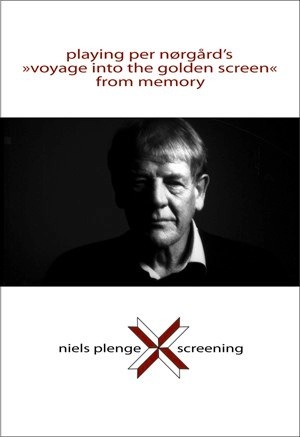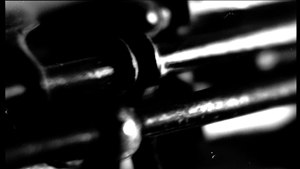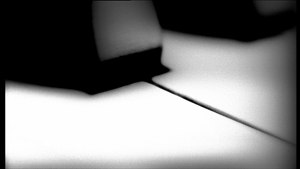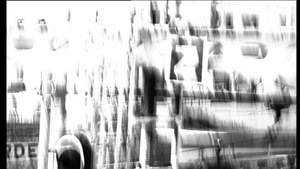See ‘Screening’ here.














● Screening Booklet Text
SCREENING REMIXED RECONSIDERED AND REVISED
Playing Per Nørgård’s ‘Voyage Into The Golden Screen’ from memory
1.
This project is about memory. There is no doubt in my mind. Music is always related to memory. As a small child being raised by your family, teachers and other adults, you are born into a society with a certain conception of music. Not to mention the often destructive ambitions that parents can project onto their small dear ones. Let’s just say that what is in your ears is on your mind. And when later in life you choose to do music yourself, either as a composer trained at a music academy or as a performing musician of any kind, you’re bound to reproduce to some extent what you already know, so you are always experienced. However groundbreaking your musical efforts and inventions might be, they will always be rooted and have their point of departure in existing musical systems.
When a jazz musician touches the fingerboard of the double bass, the sound to be heard on the stroke of the string is already there as an imagined possibility, in the head of the composer or the musician, in the notation on the page, and as an inherent possibility in the construction and tuning of the instrument. Even if the instrument in the heat of the night has gone out of tune, the more skilled the musician the faster the fingers correct or compensate.
Before you bang the skin, pick the string, blow the reed, hit the key, memory is always there. When creating never previously heard sonorities or new musical strategies there is still something familiar. That is if what you’re doing is to be considered as music. In that sense we are always standing on the shoulders of others – but it’s up to you in what way you will pay respect to your heritage. Shine it or smash it!
2.
In the summer of 1987 I was travelling around in the South of France together with my then girl friend. Once on a campsite, the sound of trains kept us awake most of the night. Or rather we both wanted to stay awake, because the shunting of heavy freight wagons produced such a fascinating squeaking and whining sound. It reminded me of a composition by Per Nørgård that I had heard some years earlier.
At home I had a cassette tape with a recording of a radio concert from 1981, which I had been listening to repeatedly. So being quite familiar with this piece, I now remembered it and imagined that I was hearing substantial fragments of the first movement being played by trains that night. As a result, for the next twenty years I went round with the idea of reproducing ‘Voyage Into the Golden Screen’ using only train sounds. Finally being encouraged by friends and colleagues, the project got on track.
First I couldn’t remember exactly where we had heard the trains, but in my thoughts Toulouse sounded right. So I checked maps and satellite photos on the internet but that didn’t give me any certainty. When I called my travelling companion, she corrected me. It was her belief that Bordeaux was the right spot. Researching it, I found an area just outside Bordeaux with a lot of tracks clearly meant for assembling trains, but the three-year-old satellite photo didn’t reveal whether the shunting area was still being used. And there was no campsite. Maybe the whole thing had been closed down or maybe modern railway technology had changed the timber. I needed an answer and hearing is believing.
One evening in july 2007 I check in to the Hotel California on the opposite side of the street to the railway station Gare Saint Jean in Bordeaux. My room has a balcony over the street, so with the door open I can hear the trains approaching and leaving. So here I am in the South of France trying to hear what I thought I heard twenty years ago.
Just before midnight I grab my sound equipment. Earlier same night, I had a most fantastic dinner at a nice little restaurant – a most unlikely find in this neighbourhood with its street hookers, stripper bars and cheap hotels – so it’s tempting to let the vin rouge consumed over dinner evaporate in my bed. But I only have three days and three nights so I’m determined to walk down to the shunting area. It is a six kilometer trip through darkened suburbs and desolated industrial areas. Being a little off the normal tourist route, I have printed my own map, so I’m very confident. But I still don’t know what I will hear.
Trying to find my way through some forest-like wasteland with small watery ditches and creeks I have to rely on my fairly good night vision. The moonlight filtered through a cloudy sky and the treetops only give vague indications of small ramifying paths. But the soothing sound of frogs assures me that everything is all right. According to my map, which I consult by torchlight, I must be very close. Now I can hear the trains, and suddenly after crossing yet another branch of the channel system I find myself almost right on the rails looking over a small separating fence. I run a whole sound tape for an hour, surprised that the French mosquitos are so considerate.
The next night I went down there again, but now more familiar with the area I let a taxi drop me off nearby, this time deciding on the other side of the shunting area. Entering a small hole in a high wire fence gave me access to a gigantic empty parking lot stretching like a tongue into the shunting area. This time it was even more rewarding. A symphony of train sounds kept me busy for a couple of hours. At three o’clock in the morning I made my way home by foot to the waiting hotel bed.
3.
In 1968-69 the Danish composer Per Nørgård wrote ‘Voyage Into the Golden Screen’. The title was taken from a beautiful song by Donovan Leitch. Being a former flower power child, on the double album ‘A Gift From a Flower to a Garden’ Donovan now performed more adult aspects of his talent. He was one of the first pop stars with a drug sentence, but this album was a much more responsible enterprise, maybe under the guidance of his new father figure, guru Maharishi, or more likely his pregnant wife and (as Donovan adds himself) under the gentle influence of mother nature.
At the end of the first disc of the album, the hippie dream is invaded by reality. There is a land not far from the ears of sound, the eyes of sight can’t see, Donavan sings in ‘The Land of Doesn’t Have to Be’, and then seagulls and waves washing against the shore are heard. Someone is singing and I think it’s me. A crying baby is heard at the beginning of the second disc that is dedicated to the little ones with mystic enchanted fairytale songs. Increasingly, this second disc captures small sound bites from reality or some kind of reality, again there are the sea, the gulls and a lot of other bird sounds.
Per Nørgård’s ‘Voyage Into the Golden Screen’ has apparently no other connection to Donovan’s but for the confidence in the intangible and the lightness of the music. Here Nørgård for the first time in a published work elaborates his infinity series which he reportedly had discovered some years earlier. The first movement in particular is very transparent with strings and reed instruments playing subtle sounds. Here the starting notes (G and A-flat) of the infinity series in the second movement are intonated by accidental beats, due to quarter tone tunings in some of the strings to a low A-flat, producing interference.
4.
Unfortunately, and despite my great expectations, the recording from the second night in Bordeaux was almost ruined by some kind of malfunction in the digital conversion or storing on the tape. Not all memory is accessible. But I insisted on making the best of it – not believing in divine intervention – and thinking that this could serve as an artistic approach. Parts of that distorted tape recording are heard now and then in my work. Possibly I also cheated a little, by recording crystal wine glasses tuned by adding water drop by drop in order to attain the right quarter tone steps.
The important thing was to emphasize tonal values in the original material of the recorded train sounds without too many of the kind of alterations, such as pitch shifting and filtering, that are normally tempting in computer editing. At this point I can’t deny being influenced by the French school of musique concrète. One of the first attempts in this field is called ‘Etude aux chemins de fer’ (Railroad Study), by Pierre Schaeffer. It appeared in a small suite of five ‘Etudes de bruit’ (Noise Studies) from 1948. From now on noise could be the source of artistic creation rather than nervous breakdowns.
In an analysis of his experiences of the Groupe de Recherche Musical at the French national radio, Pierre Schaeffer warns against too much intentional manipulating which can weaken and caricature the original sound. Instead he speaks of associations with the musical object. Most natural sounds have melodic, harmonic, rhythmic and dynamic profiles. You only have to use your ears and your memory to focus. And a little selective editing.
5.
The second movement of Per Nørgård’s ‘Voyage Into the Golden Screen’ has a strict mathematical structure, but is nevertheless very beautiful. In mirroring the two starting notes G and A-flat, on the axis of an intersecting middle line, their reciprocal distance in tonal steps defines the following notes – which in turn form the basis for the next calculation of notes, and so on. Although Nørgård’s infinity series is admired by the fractal alchemists of the eighties as one of the most beautiful series, it is not a work of science but the work of an artist.
The flute plays all the notes of the row, the clarinet plays every second, the horns play every fourth note. So the more powerful the instruments, the more seldom they play. The last instruments only play every 256th note. Due to the characteristics of the infinity series every group of instruments plays the series, but at ever slower tempi. Theoretically, the series could continue forever, but it stops at note number 1024, presumably to avoid exceeding the range of the instruments.
It is not pure automation. Somebody has to do the mis-en-scène. The composer has given directions for this interaction. The conductor and the musicians have to listen carefully to what is played. The audience can choose to follow one melodic current or surf from wavelength to wavelength, or try to capture the whole group of sailboats moving at different paces against the horizon. This is how Erling Kullberg explains that the work in a strange way points out that our expectations presuppose memory. When immersed in listening you can soon predict what the slower instruments are going to play and when, because you have already heard it in the faster groups.
I have tried to incorporate this structure in my piece through a visual link to the instrumentation of Per Nørgård’s work. Not an ensemble of musicians playing the piece, but just the instruments in a waiting posture before or after a concert. As there were no actual live performances of ‘Voyage Into the Golden Screen’ or other concerts with this group of instruments during my time of shooting the film the solution was to visit a historical music museum. This underscores even more the relation to memory.
In Part Three of ‘Screening’ 64 shots (63 of the instruments and one shot of the composer) are shown with the duration of one frame each and then looped 16 times. The next time the duration of every shot is two frames and this series is looped 8 times. The following duration is 4 frames in 4 loops, then a sequence of 8 frames twice looped and finally the 64 shots have a duration of 16 frames each. These figures give a duration of 1024 frames for each section. The conclusion is a shot of same length showing Per Nørgård. I actually shot a full roll of film simulating the screen tests by Andy Warhol but ended up only using a small fragment. This final shot is underscored with a soft version of the 1000 Hertz test tone that has been indicating the start of each section with a beep. See also ‘Infinity’.
6.
Having this fancy for mathematical thinking, I have also learned that an infinite line runs infinitely in both directions. I have heard that it’s possible to do the backward calculation for the notes up to Per Nørgård’s starting point, which would complement the infinity series, but I just reversed all the original notes of the composition. In the first version of my work you could hear this being played repeatedly by midi instruments at high speed, until the final notes A-flat and G is reached, which originally was the starting point of ‘Voyage Into the Golden Screen’. But I deleted that part in the Remix Version.
7
In general my memory concerning events, names and facts is lacking, but I always recognize a sound. Even the smallest sound can awake a memory of some experience one thought forgotten long ago. The sound of a clock ticking in your grandma’s house, your mother rattling the pots and pans in the kitchen or a tram in the street can trigger pictures and visions of a rosy or maybe more dark past. Because sound contains information about the object or the person that was the origin of the sound itself sound can become a carrier of memory. And as I stated earlier, the act of playing or hearing music is always dependent on the experience of previous musical events. I started a journey wanting to revisit an ideal place in my memory but maybe what I found wasn’t what I actually heard in the first place or wasn’t even close to what I remembered.
Originally I was hearing the sounds of shunting trains at night. This I interpreted as or imagined could be some random version of the first part of ’Voyage Into The Golden Screen’. At least there was a similarity in the sounds. Twenty years later I tried to go back to the same spot hoping to repeat the event, but I’m not quite sure I actually found the right place. Also the trains, the railway installations and the rails could meanwhile have been altered so they now sounded differently. I just recorded what I was offered in Bordeaux.
The first time I never saw the actual sound sources so I decided to shoot the pictures in daylight and at the nearby railway station, which gave me the opportunity to get much closer to the trains. I chose a super contrast graphic film with an exposure index of 4 ISO. This means a lot of light is needed. It would have been impossible to shoot anything with this film at night. In addition I also made recordings in Copenhagen so a link to the original composition of Per Nørgård was established.
So my idea was not to perform Per Nørgård’s work accurately note by note but to let the sounds of the shunting trains interpret some impressions that arose when I was hearing the music. Instead of an academic approach, or playing the music by the right combination of instruments as intended by the composer, I wanted to explore my fascination of the music and also of the train sounds, thus accentuating the degree of abstraction needed in any piece of art. In exactly the same way as Per Nørgård’s music is an interpretation of a naturally occurring series of numbers. In the train sounds I focus only on the two starting notes of the infinity series. The rest I presume you can calculate or imagine yourself.
’Screening’ was shot with a Bolex H16 Reflex and an Arriflex 16SR camera on two different super contrast films, Kodak 7363 and Agfa ST-8D. The exposed films were divided into shorter pieces which I developed by hand in a ordinary darkroom and afterwards they were assembled in the right order. The sound was captured with a Neumann RSM 191 microphone, recorded on DAT tape with a Sony TCD-D7 and finally edited in ProTools.
In the first version from 2008 the film was transferred to PAL SD video, but in 2015 the material was scanned to 1920x1440 pixels that revealed a lot of new details in the picture. It gave rise to some changes in the editing and this remixed version in HD.
Niels Plenge 2007/2015, 16mm film transferred to HD video, 16 min